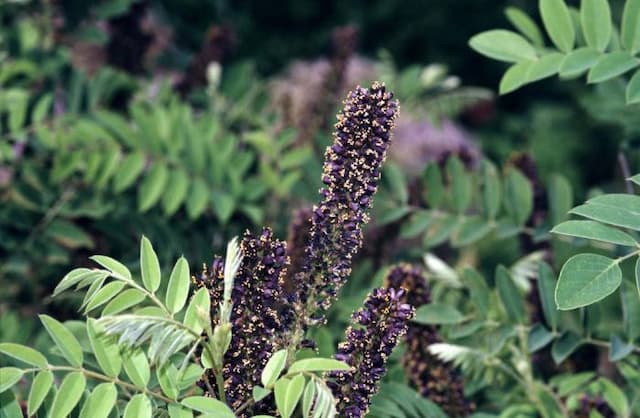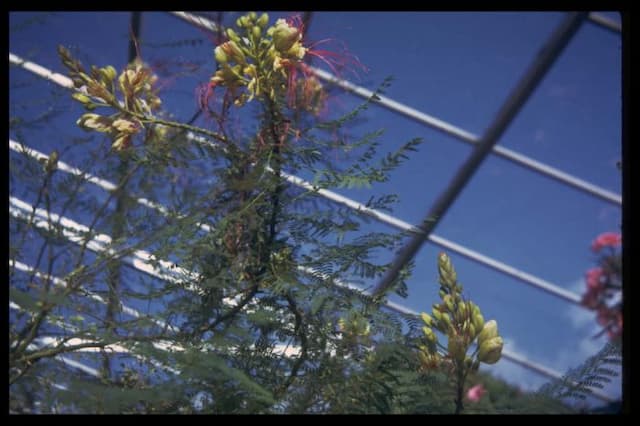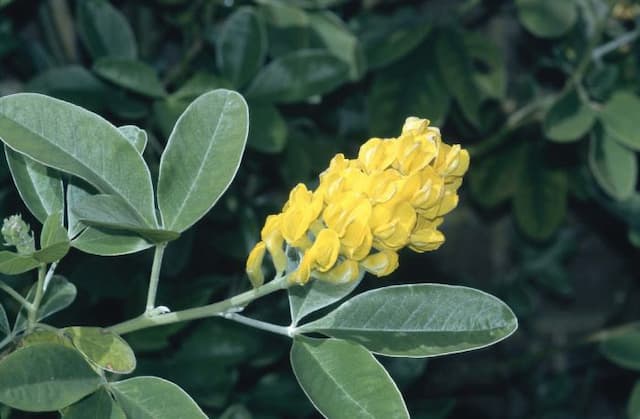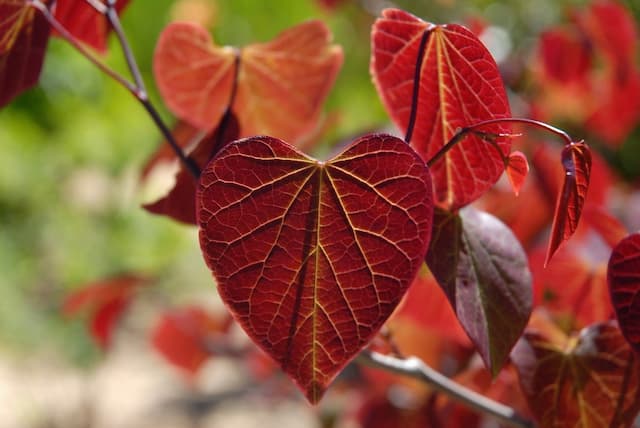Sweet pea Lathyrus odoratus 'Chris Harrod'

ABOUT
The plant known as sweet pea 'Chris Harrod' exhibits a striking and ornamental appearance. This variety is celebrated for its delightful flowers, which present in a captivating mix of colors. The petals are predominantly a deep pink or rosy hue, yet they possess a subtle blend that may include lighter shades, creating a gradient effect that draws the eye. The flowers are typically large and frilly, with a romantic, ruffled look that adds to their charm. Sweet pea 'Chris Harrod' boasts a profusion of these blooms, which emerge on long, slender stems that are tailor-made for cutting and bringing indoors to create fragrant bouquets. The foliage of the plant consists of bright green leaves, which are delicate and small, offering a soft, feathery background that accentuates the vivacity of the flowers. This foliage is often seen climbing or sprawling, depending on how the plant is supported or allowed to grow. Additionally, the plant is known for its delightful fragrance, which is strong and sweet, capturing the essence of spring and early summer. This alluring scent makes it a popular choice for gardens where aromatic plants are desired. Overall, the sweet pea 'Chris Harrod' is praised for its exquisite blossoms and the pleasant sensory experiences it provides through its sight and scent.
About this plant
 Names
NamesFamily
Fabaceae.
Synonyms
Sweet Pea.
Common names
Lathyrus odoratus.
 Toxicity
ToxicityTo humans
The common name for Lathyrus odoratus 'Chris Harrod' is sweet pea. While this plant is appreciated for its fragrant flowers and is popular in gardens, some parts of the plant are toxic to humans if ingested. Specifically, the seeds and the fruit pods contain a compound called aminopropionitrile, which can cause a potentially serious condition known as lathyrism when consumed in large quantities. Lathyrism is a neurological disease that can lead to paralysis and skeletal deformities due to its effect on collagen synthesis. Symptoms of mild poisoning may include lethargy and convulsions. Always be cautious around ornamental plants like sweet peas and ensure that seeds and pods are not ingested.
To pets
Sweet pea, the common name for Lathyrus odoratus 'Chris Harrod', is also toxic to pets. Dogs, cats, and other animals may suffer from lethargy, convulsions, or other neurological symptoms if they consume the seeds or fruit pods of this plant. Like in humans, the toxin in sweet peas can cause a condition called lathyrism, which in severe cases can lead to paralysis and skeletal abnormalities due to disruption of collagen synthesis. It's essential to keep pets away from sweet peas, primarily focusing on preventing them from ingesting the seeds and pods, to avoid the risk of poisoning.
 Characteristics
CharacteristicsLife cycle
Annuals
Foliage type
Deciduous
Color of leaves
Green
Flower color
Mixed
Height
6 feet (1.83 meters)
Spread
1 foot (0.3 meters)
Plant type
Climber
Hardiness zones
2
Native area
Mediterranean
Benefits
 General Benefits
General Benefits- Aesthetic Appeal: Adds vibrant colors and a pleasant fragrance to gardens and landscapes.
- Attracts Pollinators: Draws bees, butterflies, and other beneficial insects, aiding in pollination.
- Easy to Grow: Adapted to a variety of soil conditions and generally easy to care for.
- Seasonal Interest: Offers a seasonal display of blooms typically in spring and summer.
- Versatility: Suitable for trellises, walls, fences, and as cut flowers for indoor decoration.
- Non-Invasive: Tends to be non-invasive, reducing the risk of overtaking other plants.
 Medical Properties
Medical PropertiesThis plant is not used for medical purposes.
 Air-purifying Qualities
Air-purifying QualitiesThis plant is not specifically known for air purifying qualities.
 Other Uses
Other Uses- The sweet pea is often used in floristry for bridal bouquets due to its delicate fragrance and attractive flowers, symbolizing departure or goodbyes.
- In education, sweet peas can be used in school gardens to teach children about the growth cycle of plants and the importance of insect pollinators.
- Artists and illustrators may use sweet pea flowers as subjects for botanical illustration, capturing their diverse colors and forms.
- Sweet peas can be planted in memory gardens as a way to create a space of remembrance, using their fragrance and beauty to evoke memories of loved ones.
- These flowers can be used as natural confetti at weddings or celebrations, as their petals are biodegradable and less harmful to the environment than synthetic alternatives.
- Gardeners might use sweet pea vines to create living privacy screens or green curtains, taking advantage of their rapid growth and dense foliage.
- Photographers might seek out sweet pea flowers for macro photography, exploring the intricate details of their petals and tendrils.
- When dried, sweet pea petals can be incorporated into potpourri mixes alongside other fragrant dried flowers and spices.
- Culinary enthusiasts might use the bright flowers of the sweet pea to decorate cakes or desserts, though the flowers are not edible and should be removed before consumption.
- The stems of sweet peas can be woven into flower crowns or boutonnieres for festive occasions, offering a touch of natural elegance.
Interesting Facts
 Feng Shui
Feng ShuiThe Sweet Pea is not used in Feng Shui practice.
 Zodiac Sign Compitability
Zodiac Sign CompitabilityThe Sweet Pea is not used in astrology practice.
 Plant Symbolism
Plant Symbolism- Blissful Pleasure: Sweet pea flowers are known for their sweet fragrance, which is often associated with pure joy and pleasure.
- Goodbye: In the language of flowers, sweet peas can signify departure or a wish for someone to have a good time after saying goodbye.
- Delicate Pleasure: Their delicate blooms are representative of pleasures that are enjoyed in a gentle, subtle sense.
- Thankfulness: Gifting sweet peas can be a way to express gratitude for a lovely time or for a kind gesture someone has made.
 Water
WaterSweet peas require consistent moisture, so water them whenever the top inch of soil feels dry to the touch, generally once or twice a week. Ideally, provide about one inch of water per week, either through rainfall or manual watering. It's best to water deeply and infrequently rather than shallow and often, allowing the soil to absorb the moisture thoroughly. During the hot summer months or in dry conditions, you may need to water more frequently.
 Light
LightSweet peas thrive in full sun, where they can receive at least six hours of direct sunlight per day. Place them in a spot that is bright and receives morning sunlight, which is less intense than the afternoon sun, to protect the delicate flowers. If you live in a hotter climate, some light afternoon shade will help prevent the plants from overheating.
 Temperature
TemperatureSweet peas prefer cool weather and will thrive in temperatures between 55°F and 65°F. They can withstand light frosts, but temperatures below 20°F can be harmful to the plants. The ideal temperature range allows for vigorous growth and optimal flowering.
 Pruning
PruningPruning sweet peas encourages bushier growth and more flowers. Pinch out the growing tips when seedlings have two pairs of true leaves to promote branching. Prune periodically to remove faded flowers and seedpods, as this will encourage continuous blooming. Best time for pruning is in the late fall or early winter before new growth begins.
 Cleaning
CleaningAs needed
 Soil
SoilSweet pea 'Chris Harrod' thrives in well-draining, fertile soil with a pH of 6.0 to 7.5. The best soil mix for this plant would include a combination of garden soil, compost, and perlite or vermiculite to ensure proper drainage and nutrient availability.
 Repotting
RepottingSweet pea 'Chris Harrod' typically does not require repotting as it is an annual plant. It is sown directly into the ground or a container where it will live out its lifecycle within a single growing season.
 Humidity & Misting
Humidity & MistingSweet pea 'Chris Harrod' prefers moderate humidity but is adaptable to the ambient outdoor humidity in most temperate climates. It doesn't require any special humidity adjustments when grown outside.
 Suitable locations
Suitable locationsIndoor
Provide bright indirect light, cooler temperatures, and support for climbing.
Outdoor
Choose sunny spot, support for climbing, and protect from strong winds.
Hardiness zone
2-11 USDA
 Life cycle
Life cycleSweet pea 'Chris Harrod' begins its life cycle with the germination of seeds, which typically occurs in cooler temperatures of early spring or even late winter if started indoors. The seedlings then develop into young plants with distinctive foliage, growing rapidly under adequate light conditions. As the temperature warms, vigorous vines emerge, climbing with the help of tendrils if supported by a trellis or other structure. Flowering occurs in late spring to early summer, showcasing the plant's characteristic fragrant, colorful blossoms that continue to bloom throughout the summer. After pollination, typically by bees and butterflies, seed pods develop; when mature, they release seeds that can be collected for the next season. Finally, in autumn, the annual plant completes its cycle by dying back after seed dispersal, though in some climates, it may persist as a perennial.
 Propogation
PropogationPropogation time
Late Winter to Early Spring
Lathyrus odoratus, commonly known as sweet pea 'Chris Harrod', is best propagated by seed. The most popular method of propagation for this fragrant and vining plant is to sow seeds directly in the garden in late winter or early spring. Before sowing, it's beneficial to nick the seed coat with a file or soak the seeds in water for 24 hours to improve germination. Plant the seeds about 1 inch deep and space them 2 to 3 inches apart in well-drained soil. Sweet pea seeds typically germinate within 10 to 14 days when the soil temperature is around 55 to 65 degrees Fahrenheit (around 12 to 18 degrees Celsius). Provide a trellis or support for the seedlings to climb as they grow, ensuring they have ample room to develop and access to full sunlight.









